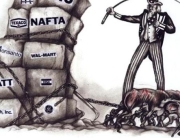*Por Marcelo Gullo
As a strategy of preservation and expansion of power, the hegemonic structures carry on, according to Guimarães, four key strategies:
1) The internal division and territorial fragmentation of peripheral states.
2) The generation of ideologies, ie, the development of concepts, worldviews and specific situations.
3) The formation of elites, ie the formation, in the countries of the periphery, of local elites and political cadres, admirers of the hegemonic power structures and ideologies produced by them.
4) The ideological dissemination of the ideas generated at the center of the hegemonic power structures, which aims to disseminate the way of life and thinking of the companies comprising the center of the hegemonic power structures.
Logically, in order to achieve the goal of its own perpetuation throughout time, the hegemonic global power structures are always looking to strengthen or deepen the subordination of peripheral states. It should be noted that the process of subordination is permanent because the subordination of the periphery is the necessary condition for the very survival of the hegemonic power structures.
In turn, the hegemonic power structures – which normally seems no or hardly flexible to the acceptance of new participants within her womb- are on the contrary, openly pragmatic to allow access of the rare peripheral states that manage to build a national power such as to avoid to treat them as “objects” of the international system, accepting that they have accumulated a quantum of power such that it must be accepted as new members of these structures. This was undoubtedly the case that allowed it to successfully incorporate, for example, in the nineteenth century, the United States after its civil war, and Bismarck’s Germany, countries that later would dispute the management of the hegemonic structures of power.
More contemporarily, the China of the late twentieth and early twenty-first century, and to a lesser extent, contemporary India, are examples of peripheral states knocking the doors of hegemonic structures with a rattle louder. The time to come will tell who corresponded the success and who failed in their attempts.
Consequently, when we say that the hegemonic power structures are formed by a network of bonds of interest and rights that binds together multiple public and private actors, whose activity tends to the permanent development of standards of behavior that will make up what is called “international order”, we are saying, too, that at the core of these structures are always the great powers.
Therefore it is necessary to point out, again following the thought of Pinheiro Guimarães, that the Great Powers are also aware – and that match the rest of the members of the worldwide power structure-that the empowerment, with terms of power, of the peripheral states alter the balance of power at regional and global levels, to their detriment.
By logical consequence, the objective of the great powers in relation to the peripheral States is to “ensure that its political, military and economic development does not affect their local, regional and global interests. This way they try initially through the mass media and training programs of future elites, convincing the population and co-opt the elites for a project of international community in which these great State sof the periphery(including Brazil) are content with a subordinated position and in which they maintain the enjoying privileges such as commercial, financial and foreign investment interests with those peripheral states”(Pinheiro Guimarães, Preface to Moniz Bandeira, 2004: 17).
For this reason we can affirm, from our own development of these ideas, that peripheral states are subjected to a “double subordination”: a “general subordination” to the hegemonic global power structures of which Pinheiro Guimaraes talks about and, secondly, a “specific subordination” that subjects the domain of the power under whose are found in the “area of influence”
The ideological and cultural subordination as the main strategy. Both strategies of generating ideologies, of elites formation, and of ideological dissemination that carry on the hegemonic power structures and the major powers, aim to essentially achieve ideological and cultural subordination of the peripheral states. By ideological subordination, the core states replace, for the achievement of its objectives, the use or threat of force by seduction and persuasion. The policies to achieve ideological-cultural subordination, ie. policies aimed at achieving the imposition of objectives of a State through seduction, have been elegantly named by Joseph Nyc as “soft power”. In this regard Nye says himself:
There is an indirect way of exercising power. A country can get 108 results it prefers in world politics because other countries want to follow it or have agreed to a system that produces such effects. In this sense, is important to set the agenda and to structure situations in world politics as it is to get others to change in particular situations.
This aspect of – we could say, get others to want what you want can be called “indirect or cooperative behavior of power”. It is in contrast to the active behavior of the person in charge consistent in making others do what you want.
Cooperative power may rest on the attraction of the ideas or the ability to raise the political agenda so as to set the preferences than others express. Parents of teenagers know that if they have structured the beliefs and preferences of their children, their power will be larger and last longer than if you have only relied on the active control.
Similarly, political leaders and philosophers since a long time have understood the power that arises from raising the agenda and determining the framework of a debate. The ability to establish preferences tends to be associated with intangible power resources such as culture, ideology and institutions. This dimension can be thought of as a soft power, in contrast to the hard power of command usually associated with tangible resources such as military and economic power. (Nye, .1991: 39-40)
The core states have both “Official” instruments as “unofficial” instruments to achieve ideological and cultural subordination of peripheral states. In terms of Nye, there are “official generators” -the organisms of the State- and “unofficial generators” -Hollywood, Harvard, the Bill and Melinda Gates Foundation, etc.- of “soft power”. Within the official instruments of “soft power” Nye referred amongst others to the diplomacy, media broadcasts, exchange programs, support for development, disaster assistance, contacts between hosts. To Nye the “soft power” should be directed to achieve the conquest of the minds and hearts of both the elites and the masses:
The foreign students who return to their countries and carry with them North American ideas increases our soft power, the ability to conquer the minds and hearts of others. (Nye , 2006: 17)
The ideological and cultural subordination is the most subtle and, in case to get them succeed alone, the most successful of the strategies that hegemonic power structures or great powers can carry out for the preservation and expansion of their power. By ideological and cultural subordination, the great powers are not intended to conquer a territory or to control the economic life but the “minds of men” as a tool for changing power relationships:
If it is possible toimaginethe culture and, more particularly, the politicalideology ofa StateAwith all itsconcreteimperialist objectivesin the process ofconqueringthe minds ofall citizens whomakethe policy of a StateB, we would observe that the first ofthe Stateswould haveachieved amore than completevictoryand would haveestablishedtheir domainon a base sounderthan anymilitary conquerororeconomic master.
The States A would not need to threaten to use military force or economic pressure to achieve their purposes.To do this,the subordination of State B to his will would have occurred by the persuasion ofa superior culture and th emain attraction of its political philosophy.(Morgenthau, 1986: 86)
About the importance of cultural subordination has had and has to achieve the imposition of the will of the great powers referred Zbigniew Brzezinski:
“The British Empire overseas was initially acquired through a combination of exploration, trade and conquest. But then. in a more similar way to their Roman and Chinese predecessors or their French and Spanish rivals, its staying power derived largely from the perception of British cultural superiority. That superiority was not just a matter of subjective arrogance from the imperial ruler class, but a perspective shared by many non-British subjects class. The cultural superiority, successfully asserted and accepted calmly, had the effect of decreasing the need to rely on large military forces to maintain the power of the imperial center. Before 1914 only a few thousand soldiers and British officials controlled about seven million square kilometers and nearly four million non-British people” (Brzezinski, 1998: 29).
Highlighting the validity of the concept of cultural subordination in the current international scenario, continues:
Cultural domination has been an underappreciated facet of American global power. Consider what is thought about its aesthetic values American mass culture exercises amagnetic appeal, especially on the youth of the world. That attraction maybe derived from the hedonistic quality of lifestyle it projects, but its global appealis undeniable. Television shows and American films represent about three quarters of the global market. American popular music is equally dominant, while developments, eating habits and even American clothing are increasingly imitated worldwide. The Internet language is English, and an overwhelming proportion of global conversations through computers is also originated in the United States, which also influence the content of the global conversation. Finally, the United States has become a mecca for those who are seeking advanced education. Approximately half a million of the foreign students enter each year in the United States and many of the best prepared will never return home. You may find graduates of American universities in almost all line ministries in the world …As the imitation of American ways of acting is expanding in the world, the most appropriate conditions were created for the exercise of indirect and apparently consensual US hegemony. That hegemony involves a complex structure of interconnected institutions and procedures that are designed to generate consensus and obscure asymmetries in terms of power and influence. (Brzezinski, 1998: 34-36)
The ideological and cultural subordination arises in subordinated states a ‘cultural superstructure’ which is a real glass ceiling that prevents the creation and expression of anti-hegemonic thinking and professional development of intellectuals expressing that thought. Here the use of the term “glass ceiling” aims to chart the invisible constraint on the progress of anti-hegemonic intellectuals, both in the cultural institutions and the mass media of communication.
BRZEZINSKI, Zbigniew, El gran tablero mundial. La supremacía estadounidense y sus imperativos geoestratégicos, Barcelona, 1998.
MORGENTHAU, Hans, Política entre las naciones. La lucha por el poder y la paz, Buenos Aires, Grupo Editor Latinoamericano, 1986.
NYE, Joseph, La naturaleza cambiante del poder norteamericano, Buenos Aires, Grupo Editor Latinoamericano, 1991.
PINHEIRO GUIMARAES, Samuel, Cinco siglos de periferia. Una contribución al estudio de la política internacional, Buenos Aires, Ed. Prometeo, 2005.







Seguir
Facebook
LinkedIn
Youtube